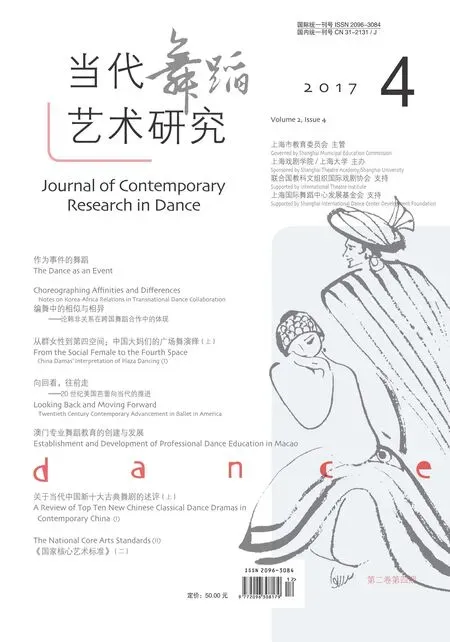Preface
2017-02-08
Observation, rumination, and epiphany comprise the process that human beings perceive the world. They are also the important means of scientif ic research. The leap of cognition and progress of thoughts of how human beings perceive the world consist in serious and comprehensive observation, profound and meticulous thinking, spiritual epiphany,and conceptual innovation. The academic journal is to record the scholars and artists’ observations with creative perspectives, the thoughts with innovative ideas, and the epiphany that reaches souls — this is the value of academic journals.
The research on dance “ontology” became a popular topic in the 1980s. The evolution of thoughts and concepts provided important theoretical support to dance at the turning point in history in need of knowing its essence and returning to its origin in the new situations. However, the study of the philosophical proposition “What is dance?” has not been completed. In “Theoretical Studies” of this issue, “The Dance as an Event” and “What is Dance?: On Dance Ontology” provide some unique insights for furthering and promoting this topic.
The great value of cultural integration and exchange for development of human beings lie in the concern for cultural diversity, exchange and intercommunication among different cultures, and promoting cultural individuality and creativity based on respect, understanding, and inclusiveness of different ethnic cultures, regional cultures, and national cultures. The article in “Cultural Exchange,” “Choreographing Aff inities and Differences: Notes on Korea-Africa Relations in Transnational Dance Collaboration” purposes to discuss or prove this spirit.
As the society becomes more open and people pursue higher level of free spirit, the living conditions of the people engaging in dance and professional dancers have been signif icantly changed. “From the Social Female to the Fourth Space: China Damas’ Interpretation of Plaza Dancing” and “Freelance Dancer: An Existence Needed to be Valued” in“Cultural Studies” give in-depth analysis of the hit subjects, “damas’ plaza dancing” and “freelance dancer.”
High-level dance competitions and dance performances not only set up an incentive mechanism but also serve as an effective platform for art exchange, playing an extremely important role in the development of dance. The status quo and trend of dance highlighted in those activities are the objects that we should pay attention to for observation,ref lection and research. In the column “On Dance Phenomenon,” we have invited a couple of experts to review,observe, and analyze the most representative international competitions and performances held in China in 2017, such as the Fourth Beijing International Ballet and Choreography Competition and Beijing Dance Festival. They identify the problems emerged from these events and discuss them from different angles. “Looking Back and Moving Forward:Twentieth Century Contemporary Advancement in Ballet in America,” “An Essay on the Fourth Beijing International Ballet and Choreography Competition,” “A Review of 2017 Beijing Dance Festival,” “‘Amidst the Wind’: A Critique of the Works of the Three Modern Dance Companies in Beijing, Hong Kong, and Guang Dong” and the pictures of the outstanding works of the 11th China Lotus Dance Awards for Chinese Classical Dance provide rich information to deepen our knowledge of these competitions and events and inspiration in helping us understand the problems in dance development and predict the trend of dance development.
In China, where there was a 5,000-year history of music and dance and abundant dance resources, Macao was once regarded as the desert of dance. However, thanks to the arduous pioneering work of contemporary dancers,professional dance schools were established in Macao and have been nurtured a great number of talented people.
The mass dance activities have been booming. The special column of this issue, “Regional Focus,” includes“Establishment and Development of Professional Dance Education in Macao,” “At Thirty, Macau Dance Association Stands Firm,” and “Rivers Flow into the Sea: An Analysis of the Status Quo and Trend of Dance Education in Macao.” By introducing the development of dance in Macao, we hope the readers have a better sense of the contemporary dance in Macao.
Contemporary dance dramas have been f lourishing in China, resulting in quantity over quality and triggering many discussions. This issue continues focusing on these discussions in articles such as “Work the Best, Reach Only the Middle; Work the Middle, Come Out on the Bottom: The Logical Origin and Destination of ‘Using Song and Dance to Perform Story’” and “A Review of Top Ten New Chinese Classical Dance Dramas in Contemporary China” in the column “On Creation.”No matter it is a ref lection or a conclusion, these articles seek to help break the bottleneck of Chinese dance dramas and help the choreographers create more excellent spiritual products to nourish the souls of the audiences.
The “epiphany” in academic research is to f ind the answer. The premise is to raise the question and the goal is to solve it. Therefore, a valuable essay inevitably f inds the historical or current problems existing in the f ield through unique observation, puts forward innovative ideas through independent thinking, so as to provide the key to solve the problem. Evidently, we see the authors’ unremitting efforts… Nonetheless, observation,rumination, and epiphany comprise the process we employ to understand the world, and this process will continue. There is a beginning, and there is no end…
